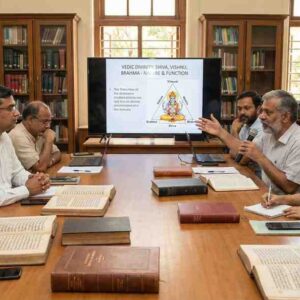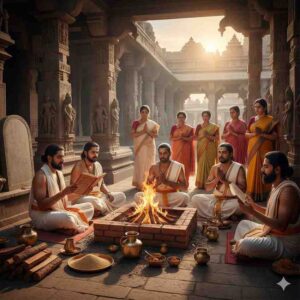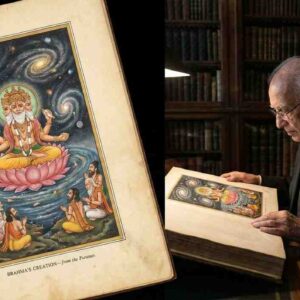TheVedasandShastras, two pillars of Indian spiritual and intellectual traditions, offer complementary yet distinct approaches to understanding life and the divine. While the Vedas focus on cosmic truths, spirituality, and rituals, the Shastras build upon these foundational ideas, providing practical interpretations and ethical frameworks for societal governance. This article explores how the Shastras interpret Vedic concepts, highlighting the differences and interplay between these ancient texts.
Vedas: The Divine Blueprint
TheVedas, consideredShruti(that which is heard), are regarded as eternal and divinely revealed. They are the ultimate authority in Hinduism, encompassing spiritual hymns, cosmic principles, and ritualistic instructions.
Key Features of Vedic Concepts:
- Cosmic Order (Rita): The Vedas emphasize Rita, the universal principle of truth and order that governs all existence. Rita ensures the harmonious functioning of the cosmos and establishes the moral and natural balance of life.
- Spiritual Core: The Vedas delve into metaphysical concepts like Brahman (ultimate reality) and Atman (soul), exploring the interconnectedness of life and the cosmos.
- Rituals and Worship: Ritualistic practices such as yajnas (sacrifices) and hymns dedicated to deities like Agni and Indra form a significant part of Vedic tradition.
The Vedas serve as spiritual guides, offering a universal perspective that transcends temporal and cultural boundaries.
Shastras: Practical Interpretation of Vedic Wisdom
TheShastras, categorized asSmriti(that which is remembered), adapt and interpret Vedic principles to address practical, social, and ethical dimensions of life. These texts, including theDharma Shastras,Arthashastra, andNatyashastra, provide detailed instructions for governance, law, and culture.
How Shastras Interpret Vedic Concepts:
- From Cosmic Order to Social Order: While the Vedas focus on Rita as a cosmic principle, the Shastras translate it into Dharma, a code of conduct guiding individual and societal behavior.
- Ethics and Law: Texts like the Manusmriti codify moral duties based on Vedic teachings, outlining roles and responsibilities across social hierarchies.
- Cultural Practices: The Natyashastra extends Vedic ideas of cosmic rhythm and order to the performing arts, illustrating how spirituality can influence creative expression.
By interpreting abstract Vedic concepts into actionable principles, the Shastras make the spiritual teachings of the Vedas relevant to daily life and societal structures.
Key Differences Between Vedas and Shastras
| Aspect | Vedas | Shastras |
| Nature | Divine revelations (Shruti) regarded as eternal. | Human interpretations (Smriti) evolving with time. |
| Focus | Cosmic truths, spirituality, and rituals. | Practical guidance on ethics, governance, and culture. |
| Authority | Considered infallible and universal. | Adaptable and contextual, based on human reasoning. |
| Purpose | To align human actions with cosmic order. | To provide actionable frameworks for societal harmony. |
| Examples | Rigveda, Yajurveda, Samaveda, Atharvaveda. | Manusmriti, Arthashastra, Natyashastra, Dharma Shastras. |
The Interplay Between Vedas and Shastras
The Vedas and Shastras are not opposing forces but complementary texts. While the Vedas lay the metaphysical foundation, the Shastras ensure these principles are applied practically.
- Rituals and Ethics: Vedic rituals are contextualized through Shastric ethics, making them accessible and meaningful in societal contexts.
- Philosophy and Governance: The philosophical depth of the Vedas informs Shastric frameworks for law and governance, creating a balanced approach to spiritual and material life.
For example, theArthashastraapplies Vedic ideas of Dharma to statecraft, while theBhagavad Gitaharmonizes devotion with philosophical inquiry, bridging the gap between faith and reason.
Contemporary Relevance
The relationship between the Vedas and Shastras offers valuable insights for modern society:
- Governance: Shastric principles from texts like the Arthashastra inspire modern governance and economic policies.
- Ethics and Law: Vedic and Shastric teachings influence ethical frameworks and legal systems in India.
- Cultural Preservation: The integration of Vedic spirituality and Shastric practicality ensures the continuity of cultural traditions while allowing adaptation to changing times.
Conclusion
The Vedas and Shastras represent two sides of the same coin, with the former providing spiritual insights and the latter translating these into practical wisdom. By interpreting Vedic concepts, the Shastras bridge the gap between cosmic order and human life, ensuring that ancient teachings remain relevant in a dynamic world. Together, they form a timeless guide for navigating the complexities of existence, offering both spiritual depth and practical solutions.













